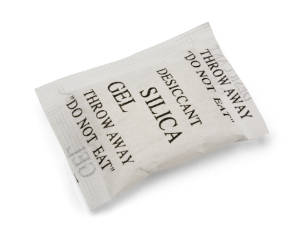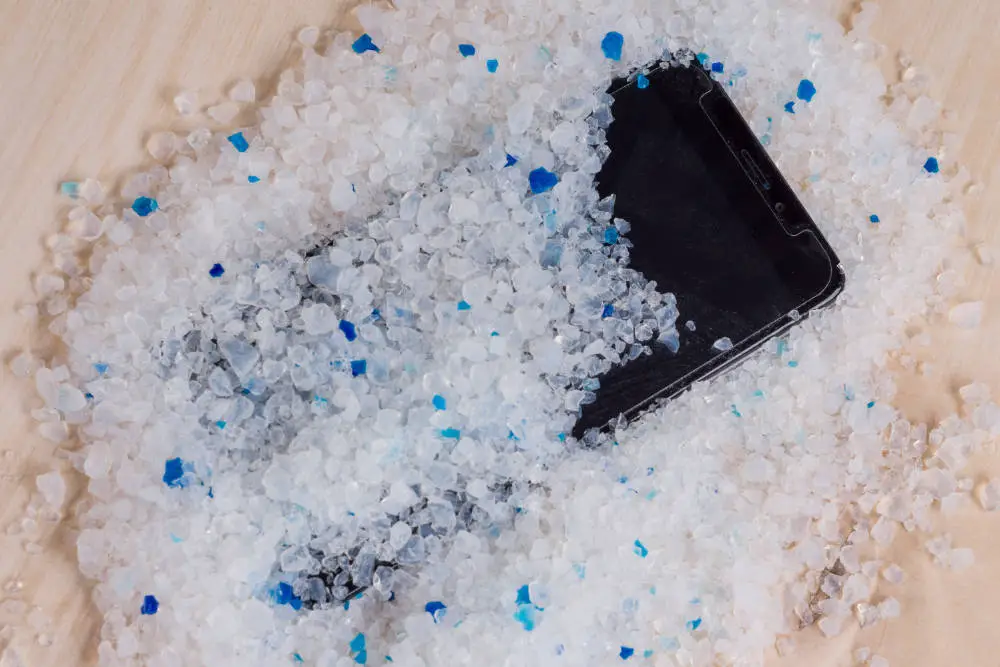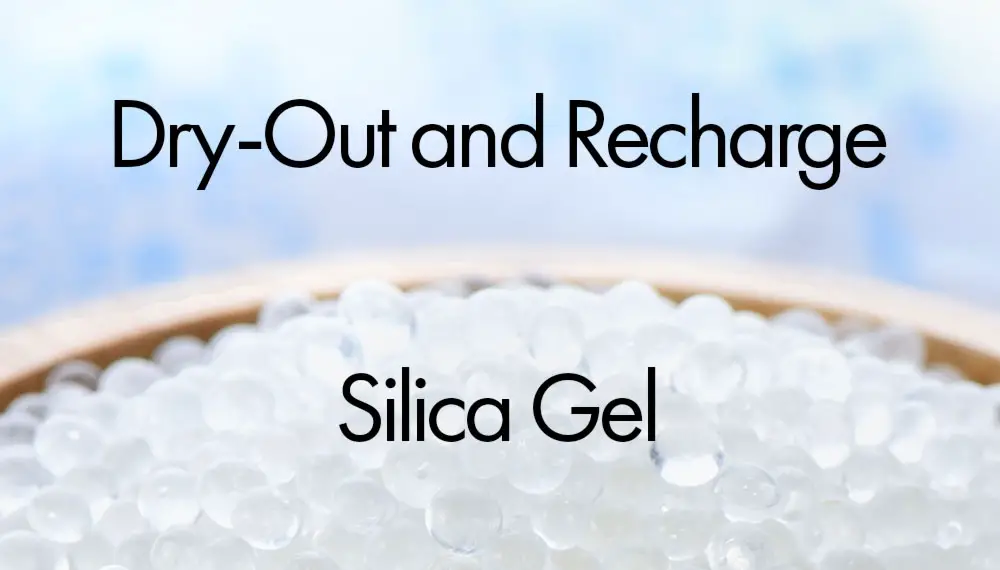If you’ve ever found a little packet of Silica Gel in the box of a new electronic device, you might have wondered what it is and what it’s for. Silica Gel is a desiccant, which means it adsorbs moisture from the air. That’s why it’s often used to keep new electronics dry and free of moisture damage during storage and shipping.
It is often used to keep moisture-sensitive things dry and free from mold or other moisture-related damage. As a photographer, you can use it to keep your camera or mobile phone free of humidity and fungus. The cool thing is that you can reuse Silica Gel packets once they become saturated with water vapor. By reusing them, you can save money, and help reduce waste.
So, how do you dry out your Silica Gel? Maybe you’ve accidentally left it in a humid environment and it has become saturated with moisture … Silica Gel is one material, that – when dry – can absorb a lot of humidity from the atmosphere, and keep it out. It is easy to use, and non-toxic, but needs to be recharged when its color changes to indicate that it’s saturated with moisture.
Table of Contents
How To Recharge Silica Gel In An Oven
Drying out Silica Gel is quite easy, and in this article, we share multiple ways in which you can dry silica gel. The most reliable and trusted method is to use a baking oven. Here is the process that we follow, to dry and recharge silica gel quickly, safely and efficiently.
- Start by placing the packets or beads of silica gel on a baking sheet in a tray. Put the tray in an oven that is set to 210°F to 250°F (~100 to 120° Celsius).
- Heat the Silica Gel in the oven for a few hours to allow the moisture in the microscopic pores to evaporate.
- Once the Silica Gel is dry, and has cooled down in the oven, you can store the beads or packets in an airtight container to prevent subsequent moisture exposure until they’re ready to be used.
That’s the easy way to dry Silica Gel, with no fuss, and no nonsense.
Alternate Ways to Dry Silica Gel
Here are two sneaky ways to recharge silica gel if you don’t have a baking (convection) oven.
1. Recharging Silica Gel Using a Food Dehydrator
You can also use a food dehydrator to dry out your Silica Gel. Just place the packets on the dehydrator tray and set the temperature to about 210° Fahrenheit (99° Celsius). Leave it in the dehydrator to dry for a few hours (I would suggest around 3-4 hours). Just be sure to check on the packets periodically.
Allow the silica gel to cool in the dehydrator before using it once again.
2. Drying Silica Gel Using a Microwave Oven
We do not recommend this method because it always seems to destroy some of the silica gel.
Some Silica Gel manufacturers say that a Microwave oven can be used to dry Silica Gel. They suggest putting the Silica Gel in a microwave-safe dish, and heating it in 30-second intervals with pauses in between to stir the beads, as a method to dry out Silica Gel.
The total heating time would be about 2-3 minutes. We have not had good experiences with using a microwave oven to dry Silica Gel, and don’t recommend it.
From some further input on Reddit, I’ve heard that people have success when heating about 1Kg of silica gel according to their manufacturer’s guidelines… Reduce the microwave power to 50%, and put the silica gel in for 4-6 minutes (the 50% power reduction means that the microwave emitter is off for 50% of the time, which comes back to our earlier stated duration), until the beads are a bright orange once again.
Allow the beads to cool completely before using them.
We’ve also explored some more unconventional alternate ways to dry Silica Gel.
What is Silica Gel?

Silica gel is a granular, vitreous, porous form of silicon dioxide made synthetically from sodium silicate. Silica gel is an amorphous silicon compound. Amorphous means that it has no ordered structure, and thus no definite shape. Wow! That’s a mouthful to say…
The gel form can contain a high percentage of water within its pores. The water is trapped and held by electrostatic forces.
The pores are incredibly small, on the order of nanometers. One gram of Silica Gel can have a surface area in excess of 3,000 square meters, which means that a surprising volume of water can be in contact with that surface, absorbing water from the atmosphere.
In short, it’s a non-reactive, hard, but extremely porous material that adsorbs water from the air. When it’s heated up, it releases that moisture back into the air, allowing it to be reused.
What Is Silica Gel’s Primary Use?
Silica Gel is an adsorbing desiccant, that dries out the air by adsorbing the humidity in the air. It reduces the humidity levels in enclosed spaces. This makes it useful in the preservation of products, museum displays, and many other moisture sensitive items.
As Photographers, We Use Silica Gel:
- In camera bags to reduce humidity
- In longer term camera storage (airtight containers) to maintain low humidity
- To quickly dry off any equipment that gets wet
- To prevent lens fungus on DSLR and Mirrorless camera lenses, Viewfinders, Action Camera lenses, Binoculars, and other optical instruments when they are put away for storage.
The Benefits of Drying and Reusing Silica Gel
- Keeps costs low
- Good for the environment (reuse stuff!)
- Low energy method of keeping things dry
- Non-toxic
- Non-reactive
- Easy to use and maintain
- Can purchase indicating Silica Gel easily, and it will last for a long time
- Keeps moisture-sensitive goods dry

So, What’s All the Fuss About? TL;DR
High relative humidity level (RH) is not good for the life of electronics and optics. Using Silica Gel beads and sachets with this kind of equipment reduces the effects of humidity-related corrosion and degeneration.
Silica Gel is very effective at reducing the relative humidity of the air surrounding it, especially when it is very high.
The good news is that when Silica Gel gets saturated with moisture, it can quickly and easily be restored to its previous effectiveness by heating for a few hours as recommended above: in an oven, or food dehydrator.
Recharged Silica Gel can be reused a few hundred times, keeping your equipment safe for many years to come.
If you’ve had a success (or failure) story while trying to reuse silica gel, do let us know. Has silica gel saved a phone or a camera lens? Leave a comment to tell us all about it. Digital Photography Life relies on its readers to get a well-rounded perspective on any topic, so that everyone can find out more, and learn quicker.





it raised the %RH of my drybox to 60% while it was still hot-
That’s because it would still be giving out humidity while it’s hot. You must let it cool down in a dry environment before putting it in to your dry-box. Perhaps that’s something to add to the article. Thanks for the feedback.